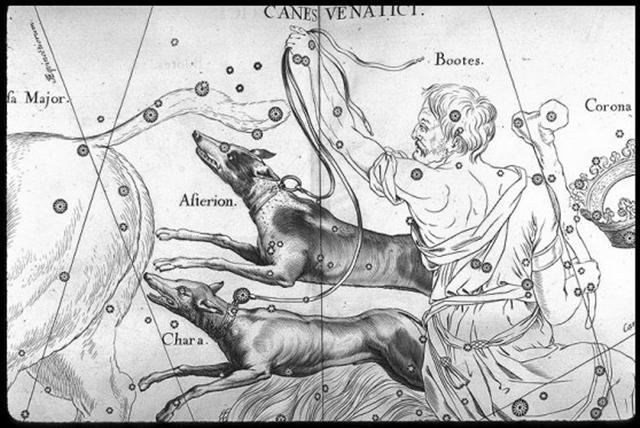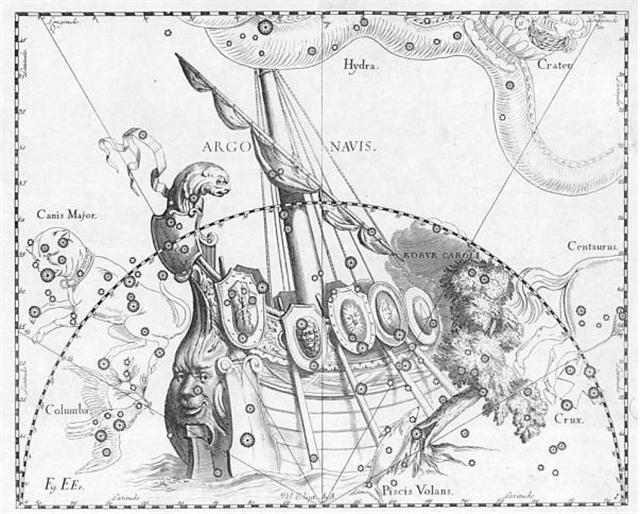8. It was necessary to change 228 to 229 and see what effects it caused. Now back to the Hunting Dogs.
Allen: "Canes Venatici, the Hunting Dogs, are the French Chiens du Chasse, or Levriers; the German Jagdhunde, and the Italian Levrieri, lying between Bo÷tes and Ursa Major. Ptolemy entered their stars among the αμόρφωτοι of the latter constellation, and the modern form first appear in the Prodromus of their inventor Hevelius. The more northern one is Asterion, Starry, from the little stars marking the body; and the other, which contains the two brightest stars, is Chara, as Dear to the heart of her master."
Asterion (β Canes Venaticorum) is not on the Asterion dog (the northern of the pair). And Cor Caroli (α) which in Hevelius' picture is at the collar of Chara, the southern dog, seems to be a word joke on COllaR of ChARα. Allen: "This star, the 12th on Flamsteed's list of the Hounds, stands alone, marking Chara's collar; but was set apart in 1725 by Halley, when Astronomer Royal, as the distinct figure Cor Caroli, not Cor Caroli II as many have it, in honour of Charles II. This was done at the suggestion of the court physician, Sir Charles Scarborough, who said it had shone with special brilliancy on the eve of the king's return to London on the 29th of May." Charles II we have encountered earlier (cfr at Niu), at the crucial time when he was defeated: ... Robur Carolinum, Charles' Oak, the Quercia of Italy and the Karlseiche of Germany, was formally published by Halley in 1679 in commemoration of the Royal Oak of his patron, Charles II, in which the king had lain hidden for twenty-four hours after his defeat by Cromwell in the battle of Worcester, on the 3rd of September 1651 ...
The date, May 29, suggests another bad night for the King. If we count its day number in our calendar it will be 80 (March 21) + 10 + 30 + 29 = 149 and its glyph number in the G text will be 149 - 144 = 5:
Ana-muri means at the end. Should we search for the culmination of Aldebaran at midnight we have to reduce 5 with 229. 5 - 229 + 472 = 248:
The curved 'tail' of hakaturou in Gb1-18 is presumably a sign which alludes to the curved tail in Ga7-16:
The heliacal rising of Ana-mua arrives before the midnight culmination of Ana-muri. The date at Gb1-18 (according to our calendar) should be searched for by moving back 229 days from May 29. 149 - 229 + 365 = 285:
However, we have discovered that Ga8-17 could mark September 16 (spring equinox on Easter Island), and if so we should have
There is a difference with 1 day, which I guess is because we have counted Gb8-30 twice when reaching October 12 by moving back 229 glyphs from vaha mea in Ga1-4. If we count Gb8-30 only once May 29 at vaha mea should be coloured black, which would make sense for a day at the end. But then we must go to Gb1-17 in order to find
|
|||||||||||||||||||||||||||||||||||||||||||||||||||||||||||||||||||||||||||||||||||||||||||||||||||||||||||||











